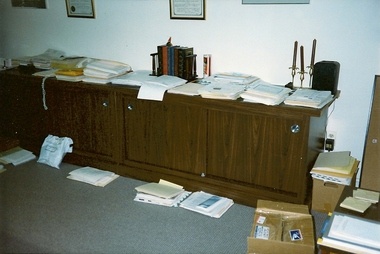Have you ever noticed that some people have piles of paper all over their office? If you do not organize by piling, you might be viewing those piles with curiosity, disgust or amazement. Why would anyone want to be surrounded by piles, especially “dysfunctional” piles of paper that take up whole sections of their office floor? After many rounds of pile busting for my clients, I have learned that many ‘pilers’ share certain characteristics:
they are visually oriented and worry that if papers are out of sight, they will be out of mind; they prefer to organize horizontally; instead of vertically (traditional filing); they have difficulty throwing papers away because they are afraid they will either make a mistake or miss an opportunity; they have difficulty making decisions because they tend to try to consider all the possibilities for use of the papers; they are easily overwhelmed by paper; once they get even a little behind on paper management they shut down and stop dealing with it; they really do not know how set up more effective systems for effectively dealing with paper.
What to do? Of course, one option is to continue using piles of paper to track projects in progress. But you’ll want to make sure they are functional piles– ones that contain papers pertaining to just one subject or project. Other options to avoid piling:
Make a commitment to MAKE A DECISION about what to do with paper the first time you touch it. 1) Is it an action item? 2) Should it be filed? 3) Should it be routed to someone else? 4) Is it trash? 5) Is it something to read? 6) Or, is it something you are undecided about? Create easy to reach places for each of those types of items. Then, put it in the appropriate place. Make a commitment to STOP SETTING PAPER ASIDE for any reason. Use a step sorter on your desk to make files visible. Have those files contain active projects or documents and forms you use frequently. Be sure to label the files in dark ink. Or, better yet, use a label maker (available at office supply stores for about $50). Use an open filing cabinet (available on wheels), desktop filing box, or crate so that you can continue to enjoy a horizontal format, but have the benefits of a vertical filing system.
Why learn how to become a functional piler?
You’ll be able to lay your hands on papers you need much more quickly. You can’t quickly find papers in a dysfunctional pile (one that contains papers pertaining to many different types of subjects or activities). Your space will feel much more peaceful. Dysfunctional piles are very noisy. Since everything is alive with energy, every piece of paper has a different type of energy. Put them all together and you have a screaming crowd. Compared to a pile of just one type of paper, e.g. tax related papers, a mixed pile is a jumble of energy that you’ll tend to avoid. If you have a number of dysfunctional piles in the same room, you’re likely to feel overwhelmed by the riot of energy and the visibility of so much paper. You’ll feel more competent and less anxious about dealing with paper. A room filled with paper piles seems to scream, “You slob! Do you really know what you’re doing?” or “You really are behind. Why aren’t you doing something about this mess?” Papers sorted into piles by category or filed away in a step sorter or open filing system have an orderly and affirming energy that is much quieter and calmer than mixed piles with no specific identities.
If you are a piler, commit to learning more effective ways to keep your papers visible and accessible while reducing the negative energy that emanates from multiple piles. Two functional piles are much quieter than two mixed piles. An open filing system is quieter than any piling system. Remember, there are options available that will meet your need for visibility and will help you retrieve the papers you need in seconds. Make the time to organize your piles into a system that really works for you.
